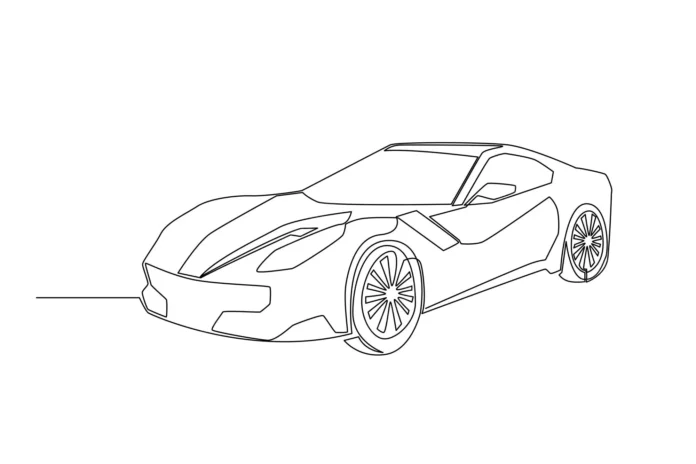Drawing a car means visualizing a car using several artistic mediums, such as sketching, drawing, painting, or digital art. From photorealistic renderings to cartoon-style graphics, there are many different ways to depict cars. This article will teach you how to draw a race car.
Overview of Car Racer Drawing
Drawing race vehicles may be a thrilling and entertaining way to show your enthusiasm for the sport of auto racing, which is a popular activity and a treasured hobby for many people.
Whether you’re a professional artist, a student, or an amateur artist, sketching car races may be a terrific method to develop your drawing abilities and produce original and exciting works of art.
It’s crucial to start with the racing car’s fundamental design and dimensions when sketching one. The car’s primary body, roof, and wheels can be outlined using basic lines and forms.

Then you may proceed to include elements like windows, doors, and headlights. The rims, spokes of the wheels, tires, and other little elements must also be considered.
Drawing cars can be done for pleasure or business purposes, such as advertising. Professionals that work in the automobile sector as designers or illustrators, as well as enthusiasts and students who want to learn how to draw vehicles, can all sketch cars.
Before construction, automotive drawings can also be used to design and develop new vehicles. By visualizing and evaluating different design concepts, automotive drawings can also be used to brainstorm and evaluate design ideas before construction.
How to Draw a Race Car
To begin, sketch the vehicle’s outline using basic lines and shapes. For the car’s main body, draw a rectangle. For the front and back windshields, draw two smaller rectangles. Draw two circles for the wheels and a triangle for the roof.

Next, add details to the car. Sketch the door lines and the side mirrors. Draw the headlights and the grill of the car.

Add the rims, spokes, and other minor elements to the wheels and tires. Ensure that the wheels’ size is appropriate for the vehicle.

Include any optional extras you want, such as the bumper or racing decals. As inspiration, you can select photographs from sources.

Lastly, apply color and shading to make the vehicle look more genuine. You may use digital tools, pencils, or markers to add highlights and shadows to the vehicle.

Once you’re pleased with the design, you can clean it up using a pen or fine-tipped marker to make it seem nice and orderly by removing extraneous lines.

Keep in mind that learning to draw is a talent that requires practice. Don’t give up if your initial tries don’t come out correctly or if you’re starting. You’ll become better with practice and experimenting with different methods.
Methods for Drawing a Race Vehicle
Here are a few various approaches to depicting a race car:
Sketching Technique:

Begin by using basic lines and forms to outline the vehicle. The main body, roof, and wheels should all be included in this. After that, give the vehicle finishing touches by adding the windows, doors, and headlights. Finally, employ shading and color techniques to make the vehicle look more realistic.
Cartooning Technique:

This technique works well for building race cars with a cartoon appearance. Start by drawing the basic outline of the vehicle, but make the lines and forms more pronounced. Include finishing touches like large cartoon-style wheels, oversized headlights, and eye-catching racing decals.
Technical Technique:

This approach works best for producing a thorough and accurate race car simulation. Draw the general outline of the vehicle first, and then add precise features and proportions using technical drawings and reference pictures. To make the vehicle look realistic, use shading methods.
Painting Technique:

Using this technique, you may create a convincing and dynamic race car. Use watercolors, acrylics, or oils to paint the vehicle after sketching its basic outline. Use highlights and shadows to give the vehicle a sense of depth and fluidity.
Frequently Asked Questions
What supplies will I need to sketch a race car?
The tools you’ll require to draw a race vehicle may vary depending on your chosen technique. You’ll need a pencil and an eraser for sketching. You may color with pencils, markers, or paint. Graphite pencils, ink pens, and digital drawing tools like graphic tablets are some of the often used supplies for vehicle drawings.
How can I sketch a racing car that seems more realistic?
Add additional realism to your race vehicle drawing using shading methods like hatching, cross-hatching, and blending. You may also utilize reference pictures to understand how the automobile ought to seem in various lighting situations. The drawing can also appear more realistic by paying attention to the car’s features, such as reflections, shadows, and highlights.
How can I get better at sketching cars?
You may routinely practice, experiment with various styles and approaches, and study the work of other artists to enhance your vehicle sketching abilities.
Additionally, you may enroll in seminars or workshops to learn new skills and obtain criticism on your work. You may also study the intricacies of various vehicles using reference pictures and films to develop your drawing skills.
How can I depict the motion of a race car?
You must pay close attention to the speed and direction of the race vehicle if you want to draw it moving. Pay attention to how the wheels and tires are positioned, and use diagonal lines and shapes to signify movement. Additionally, you may create the appearance of motion using methods like motion blur and speed lines.
Conclusion
Keep in mind that mastering the art of drawing requires practice. If you’re starting, try not to get disheartened if your initial efforts don’t go flawlessly. You’ll improve with time if you continue practicing and trying new methods.

